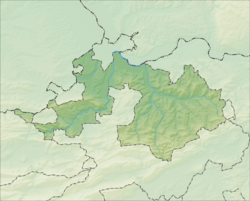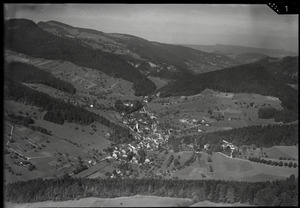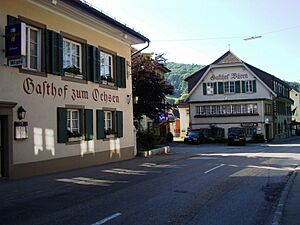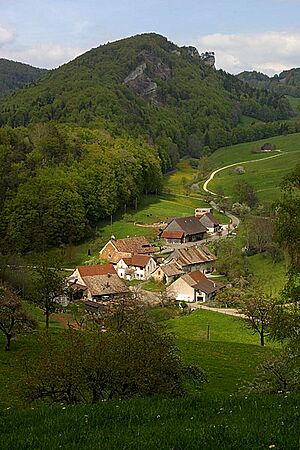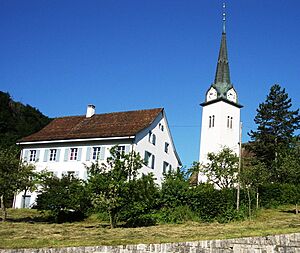Langenbruck facts for kids
Quick facts for kids
Langenbruck
|
||
|---|---|---|
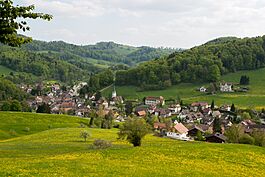 |
||
|
||
| Country | Switzerland | |
| Canton | Basel-Landschaft | |
| District | Waldenburg | |
| Area | ||
| • Total | 15.66 km2 (6.05 sq mi) | |
| Elevation | 734 m (2,408 ft) | |
| Population
(Jun 2021 )
|
||
| • Total | 958 | |
| • Density | 61.17/km2 (158.44/sq mi) | |
| Postal code |
4438
|
|
| Surrounded by | Bennwil, Egerkingen (SO), Eptingen, Hägendorf (SO), Holderbank (SO), Mümliswil-Ramiswil (SO), Oberdorf, Waldenburg | |
Langenbruck is a small town, also called a municipality, located in the Waldenburg district. It's part of the canton of Basel-Landschaft in Switzerland.
Contents
A Glimpse into Langenbruck's History
Langenbruck was first mentioned way back in 1145. Back then, it was known as Langebruccho. This shows it's a place with a long and interesting past!
Exploring Langenbruck's Geography
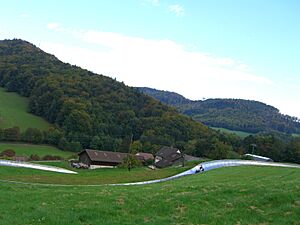
Langenbruck covers an area of about 15.69 square kilometers (about 6 square miles). A big part of this land, about 51.1%, is used for farming. Forests cover another large section, about 44.2% of the area.
The town itself, with its buildings and roads, takes up about 4.7% of the land. A tiny bit, 0.3%, is made up of rivers or lakes. Most of the water in Langenbruck is flowing water.
Langenbruck is located in the Waldenburg district. It sits on the south side of a mountain pass called Oberen Hauenstein. The municipality includes the main linear village of Langenbruck. It also has a smaller settlement called Bärenwil and many individual farm houses spread out.
Langenbruck's Coat of Arms
The official symbol of Langenbruck is its blazon or coat of arms. It features a red background. At the bottom, there's a black base. On top of this, there's a golden bridge. Walking across the bridge is a special lamb, called a Paschal Lamb. This lamb holds a white flag with a red cross on it.
People and Population in Langenbruck
Langenbruck has a population of 958 people. About 14.8% of the people living here are from other countries. Over the last ten years, the population has grown a little bit, by about 1.6%.
Most people in Langenbruck, about 90.7%, speak German. The next most common languages are Serbo-Croatian (1.7%) and Italian language (1.6%). A small number of people also speak French or Romansh.
In 2008, a little more than half the population (51.4%) was male, and 48.6% was female. Most residents, 83.5%, were Swiss citizens. The remaining 16.5% were non-Swiss residents.
Many people living in Langenbruck were born there (30.5%). Others were born in the same canton (15.0%) or elsewhere in Switzerland (32.8%). About 18.1% of the population was born outside of Switzerland.
The age groups in Langenbruck show a mix of people. About 5.2% are young children (0-6 years old). Teenagers (7-19 years old) make up 16.0% of the population. Adults aged 20-64 make up a larger portion, while seniors (65 and older) account for about 13.6%.
The historical population of Langenbruck has changed over time. You can see how the number of people living here has varied through the years in the chart below:

Important Heritage Sites
Langenbruck has a special historical site: a medieval mine in Dürsteltal. This mine is recognized as a very important heritage site in Switzerland. Also, the entire Schöntal area is part of the Inventory of Swiss Heritage Sites. This means it's a place with important cultural and natural value.
Langenbruck's Economy
In 2010, the unemployment rate in Langenbruck was 3.6%. This means a small number of people who wanted jobs didn't have them.
Many people in Langenbruck work in different areas.
- The primary sector (like farming) employs 76 people across 27 businesses.
- The secondary sector (like manufacturing and construction) has 66 employees in 8 businesses.
- The tertiary sector (like services, shops, and healthcare) employs 171 people in 35 businesses.
In 2008, there were 240 full-time jobs in Langenbruck. Most of these jobs were in agriculture, manufacturing, construction, and services like hotels, restaurants, and healthcare.
Many people who live in Langenbruck travel to other towns for work. In 2000, 283 people left Langenbruck to work elsewhere, while only 78 people came into Langenbruck for their jobs. This means Langenbruck is a "net exporter" of workers. About 15.9% of working people used public transportation, and 47.5% used a private car to get to work.
Religion in Langenbruck
Based on a census in 2000, about 49.6% of the people in Langenbruck belonged to the Swiss Reformed Church. Another 18.9% were Roman Catholic.
There were also smaller groups of people who belonged to other Christian churches, like Orthodox churches or the Christian Catholic Church. About 6.24% of the population followed Islam. A small number were Hindu.
About 15.07% of the people said they didn't belong to any church, or were agnostic or atheist.
Weather in Langenbruck
Langenbruck experiences an average of 144.5 days of rain or snow each year. The town typically receives about 1252 millimeters (about 49 inches) of rain or snow annually.
The wettest month is June, with an average of 135 millimeters (about 5.3 inches) of precipitation. It rains or snows for about 13.3 days in June. May has the most days with precipitation, averaging 14.1 days, but with slightly less rain or snow overall. The driest month is October, with about 87 millimeters (about 3.4 inches) of precipitation over 9.2 days.
Education in Langenbruck
Education is important in Langenbruck. About 37.5% of the population has finished upper secondary education. This is like high school.
About 11.8% of people have gone on to higher education. This means they attended a university or a specialized college (a Fachhochschule). Of those with higher education, most were Swiss men and women.
In 2000, 11 students came to Langenbruck for school from other towns. However, 96 residents of Langenbruck went to schools outside the municipality.
Notable People from Langenbruck
- Oskar Bider: He was a famous Swiss aviation pioneer. This means he was one of the first people to fly airplanes in Switzerland!
See also
 In Spanish: Langenbruck para niños
In Spanish: Langenbruck para niños




